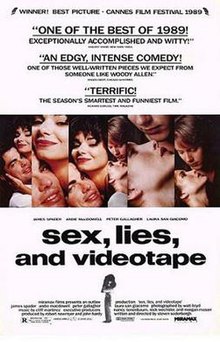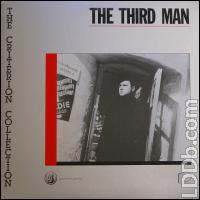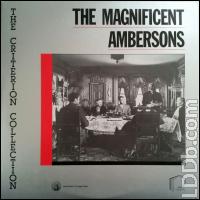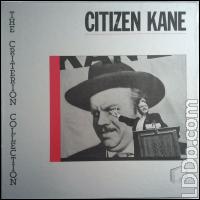Welcome to my blog series about my passion to the movies and television. I hope you enjoy what I have to say when I express my opinions and you are free to have your own thoughts.
Monday, May 21, 2018
I'm going on vacation
Hello, my readers. On May 26th, I'm going to North Carolina for a vacation to visit my brother and his girlfriend. I'll be back to write more reviews and write more passionate essays in early June. For all those who supported my work and what I do, thank you.
Sunday, May 13, 2018
Roger Ebert Archive: A Word About Laservision
Roger Ebert was one of the most well respected film critics in the film community and my favorite reviewer. But some of his reviews and essays have been difficult to find on his website. So I decided to quote essays and reviews you can find on his video guide book series written between 1985 to 2012. The first article in this Roger Ebert Archive series is about his first exposure to Laserdiscs, which he prefers than VHS for superior picture and sound quality and for adding more bonus content. The source I'm using is an emulator for a 1991 floppy disc for DOS computers that contains contents of Roger Ebert's 1986-1992 edition's of his Movie Home Companion books series. The emulator is available on archive.org. This essay about Laserdiscs was taken from his 1988 edition, published in 1987.
"It all started at one of those giant video stores out in Los Angeles, down at Sunset Boulevard, where Beverly Hills film executives wander up down the aisles the way the rest of us visit super markets. In the middle of the thousands of videocassettes was a large display of what looked like record albums. And in the middle of the display was an earnest movie fan with an armload of albums."
" 'How come,' he said to me, ' that you don't ever mention discs when you talk about video?' "
"You mean, like video discs?"
" 'Yeah,' he said, realizing he was going to have to start at square one."
" 'These are LaserDiscs,' he said, nodding at the racks and speaking with such drama that I could hear the capital D."
"Are they still making those, I said. I thought they went out of business. 'This is a completely different technology than the old video discs you're thinking of,' he said. 'These use the same technology as compact discs, only with images as well as sound. Once you've seen them, you'll never go back to old-fashioned tapes again, if you can help it.' "
"He started talking to me about the really neat expert's edition of 'Citizen Kane' that was on LaserDisc, and about how good the music on 'The Cotton Club' sounded with digital sound on LaserDisc, and how about LaserVision owners (I could hear the capital V) considered themselves the gourmet of video."
"But meanwhile, my attention was captured by a large-screen rear-projection TV that was showing 'Top Gun'. The jets were taking off from the aircraft carrier, and the sound was so good, it sounded like the movie itself. In fact, some of it seemed to be coming from behind me."
"That's a pretty good cassette of 'Top Gun', I said"
" 'That's a LaserDisc with full surround sound' he explained patiently. 'You can put speakers behind you, and LaserVision will give you true Dolby stereo and true separation. Also, anyone who owns a big-screen TV and doesn't have a LaserVision player ought to have his head examined. Cassette tapes have about 260 lines of horizontal resolution. LaserDiscs have about 380 lines. Also, you get true blacks and true whites. Black-and-white never looked better than on laser.' "
"I looked at 'Top Gun' again. He was right. Not only was the sound amazing, but the picture on the big-screen TV was sharper than most of the pictures I've seen on smaller TVs. The guy had me sold; when I got back to Chicago, I started experimenting with LaserVision."
"Right after I bought my new Pioneer 838 LaserVision machine home, I attached both my VCR and my LaserDisc machine to my TV. I loaded a VHS cassette tape version of 'The Third Man', one of the greatest movies of all time, into the VCR. I loaded a LaserDisc of 'The Third Man' into the laser machine. I started them at the same point, and toggled back and forth between the two signals, to see if LaserVision really is, as he claimed, the future of serious home video. It wasn't even a close contest. The taped version was muddy and fuzzy, but the quality of the LaserDisc version approached the best 6-millimeter film prints of the movie I had seen. In the early scenes, as Joseph Cotten swings off the train and into postwar Vienna, the LaserDisc picture showed his patterned vest, his tweed sports coat and his dark overcoat. On VHS cassette, it looked like he was draped in assorted dark shapes."
"The difference in sound was even more startling. The VHS tape of The Third Man (a reputable version from Media Home Entertainment - not one of those cheap bootleg tapes) opened, of course, with the immortal 'Third Man Theme' by Anton Karas on the zither. But the sound track was cold and distant, with a slight hiss. On LaserDisc, the music was clear, bright, and warm (and in mono, just like in the original movie)."
"I'd stacked the deck just a little. My laser version of 'The Third Man' was from the Criterion Collection, A Los Angeles - based manufacturer of exceptionally high-quality LaserDiscs. It had been mastered with loving care from a good-condition original British print of the movie. And because of it's British origins, I noticed one dramatic difference between the two versions: On the U. S. tape, the opening monologue is spoken by Joseph Cotten. In the British version, it's by Trevor Howard. (That must not be the only difference; the LaserDisc is three minutes longer than the U. S. cassette)."
"Since I conducted that test I have become another of the small but devoted group of fans of LaserVision, a long-overlooked video technology that is finally enjoying a boomlet. Pioneer, which manufactures most of the laser players for sale in America and many of the discs, claims that LaserVision images are 60 percent sharper than any videocassette. And the sound, of course, is of CD quality - a LaserDisc is essentially a Compact Disc that includes images as well as sound."
"Somehow, I'd gotten Laservision confused in my mind with those old RCA videodisc players that were around in the early 1980s, the ones that played videodiscs with a needle. RCA dropped that technology, and about the same time MCA/Universal also abandoned its equally ambitious system, named DiscoVision. Consumers agreed that discs had better resolution than cassette tapes - but disc machines couldn't record off the air, and VCRs could."
"As a result, more than 50 million VCR machines have been sold since 1980, in the greatest consumer appliance windfall since television itself. Meanwhile, however, Pioneer persisted with the basic idea of a videodisc played with by a laser beam. And when compact discs got hot two years ago, laservideo technology hitched a ride on the CD coattails."
"What is a LaserVision machine? It is a compact, flat box a little smaller than most VCRs. It has a tray that slides out, and on the tray, you place a shimmering silver LaserDisc. (The discs themselves, much more aesthetically pleasing than clunky cassettes, look as if they should be the table service in 'Close Encounters of the Third Kind'.) The tray slides noiselessly back into the player, and the disc supplies a noticeably better picture and dramatically better sound than I ever saw or heard on a television. Because the laser beam merely reads the disc, they are virtually indestructible even after hundreds of plays."
"Pioneer's top-of-the-line machine, the Model 909, combines laservideo with a CD player, so you get two machines for the price of one (about $700). Their videodisc-only machine, the Model 838, sells for $549, with a street price around $475 - about the same as VHS Hi-fi. In the bargain basement, a Magnavox videodisc player, made by Pioneer, can be mail-ordered for $495, and the Criterion Collection will throw in $100 worth of LaserDiscs from its catalog. (Phone 213-475-3524 for more information.)"
"There are currently 1,700 LaserDiscs available, as compared with around 10,000 VHS cassettes. Prices are the same or as cheaper than cassettes - from $19 to $34, with most titles at $29.95. Full-length operas and double-disc sets that provide special stop-action and double sound tracks range from $39 to $99. About 10 percent of video stores now carry LaserDiscs; most have rental bins."
"Many of the major video suppliers issue video discs, but the Criterion Collection is true connoisseur video. Not only is the quality of the Criterion discs superb, but the company is run by movie fanatics who have added several bonus features to many of its discs."
"To understand the features, you need to know that Laserdiscs come in two formats: standard and expanded. Both generate the same picture quality on TV but paradoxically, standard offers more features than expected. Both features can be played on all laser machines. With the extended format, a feature length movie can be squeezed on two sides on one disc, and the viewer can use remote control to fast-forward, reverse, or to instantly cut to any of the "chapters" (scenes in a drama, songs in a musical). Unlike tapes, discs offer immediate access to any point in a movie without the tiresome rewinding of the tape."
"With the standard format, however, several additional features are available. The format requires roughly twice as much memory space, so standard feature movies come on two discs. Any frame of the movie can be frozen (with a true, rock-solid freeze-frame instead of the shivering frames on VCRs). Film can be advanced one frame at a time, or at quarter-speed, half-speed, or three-fourths speed-up to twice normal speed. Also, if you know the number of any individual frame in the movie (supplied by a digital readout in the upper corner in the picture), you can advance directly to that frame."
"And - here's the amazing part - many Criterion LaserDiscs use a second, separate parallel sound track to supply a commentary by an expert on the film. For the Criterion versions of Orson Welles's 'Citizen Kane' and 'The Magnificent Ambersons' Welles expert Robert Carringer of the University of Illinois provides a blow-by-blow account of the movie's history, technique, and narrative strategy, and explains the special effects as they're happening. The remote-control device allows the viewer to listen to the movie, to the expert plus a background check, or to both at once."
"On the last side of the 'Ambersons' package, Criterion even supplies still frames of the entire script, the art director's drawings, the movie's publicity photos, and an interview with Welles about how the film was butchered by the studio. Also on the second sound track, there is Welles's Mercury Theater radio version of 'Ambersons'. 'Kane' also includes dozens of production photos, and supplies the movies original coming attractions trailers."
"The sound tracks on LaserDiscs include not only stereo but a separate "surround" track that gives true, separated surround-sound instead of the approximation on VHS Hi-Fi. Because most TVs have shoddy speakers, it's advisable to run LaserDisc sound through the stereo system. The newest wrinkle on LaserDisc is full digital sound, now available on over 100 discs. I listened to the LaserDisc digital version of Francis Ford Coppola's 'The Cotton Club' and decided that it was so good that, frankly, I needed better speakers."
"True, LaserVision will not record off the air. But with more than 50 million VCRs in existence, a lot of people are buying a second one to make copies of their favorite tapes. LaserDiscs can be copied onto tapes just like ordinary cassettes, and the copy is better because the disc itself approximates good broadcast quality. So anyone considering a second VCR might seriously consider a LaserVision player instead."
"The key advantage of LaserVision over the earlier disc-based video systems is, obviously, the enormous popularity of it's first cousin, Compact Discs. If you intend to buy a CD player and find that, for a little more money, you can add LaserVision - why not go for it? And once you've seen a LaserDisc on your own TV, it's hard to get used to cassette tape again."
Subscribe to:
Posts (Atom)
How The 90s Indie Boom Changed And Challenged American Cinema?
In the 90s, a new generation of younger filmmakers were making their most renowned works either in or out of the major Hollywood studios. Th...

-
WHERE HAVE I BEEN: 2022 was a really busy year for me. I've been through four family weddings in the past summer and fall. It's also...
-
On May 28th, 1993, two iconic video game characters named Mario and Luigi arrived on the big screen. With a budget of $48 million, it gro...
-
Before I write the article, I would like to tell you about my vacation to North Carolina. I had a good time with my family. We went swimming...




